Mandala art offers endless creative possibilities for relaxation and expression. Try nature-inspired designs with seasonal colors, precise geometric patterns, or dreamy watercolor techniques. Dot art creates intricate details, while mixed-media adds texture and dimension. Digital tools provide perfect symmetry for beginners. Transform your mandalas into home décor items like coasters or wall art. Cultural traditions worldwide can inspire unique designs with meaningful symbolism. These ten approaches reveal a world of meditative artistry.
Key Takeaways
- Nature mandalas use botanical elements and seasonal colors to create peaceful designs reflecting the changing rhythms of the natural world.
- Geometric mandalas require precise tools like compasses and rulers to create perfectly symmetrical patterns from basic shapes.
- Watercolor techniques create soft, flowing mandalas with blended pigments, while adding salt creates fascinating textures.
- Dot art mandalas build intricate patterns by placing precise dots in expanding circles from a central anchor point.
- Mixed-media approaches combine various materials like paints, markers, and natural elements for textured, multi-dimensional mandala designs.
Nature-Inspired Mandala Art: Bringing the Outdoors to Your Canvas
When artists seek inspiration for their mandala creations, nature provides an endless source of beautiful patterns and designs. The swirling petals of flowers, the delicate veining of leaves, and the spiraling forms of shells can all transform into stunning nature-inspired mandala art that calms the mind and soothes the soul.
Working with greens, soft blues, and gentle pastels helps artists create a sense of peace as they layer intricate details into their designs. Many creators find that drawing these organic patterns feels like a mini-vacation for the brain!
The process of carefully arranging natural elements in circular patterns becomes a form of meditation, helping artists connect with the environment while reducing stress. Plus, each nature mandala tells a unique story about the artist’s personal relationship with the natural world around them.
Geometric Mandala Patterns for Precise and Stunning Results
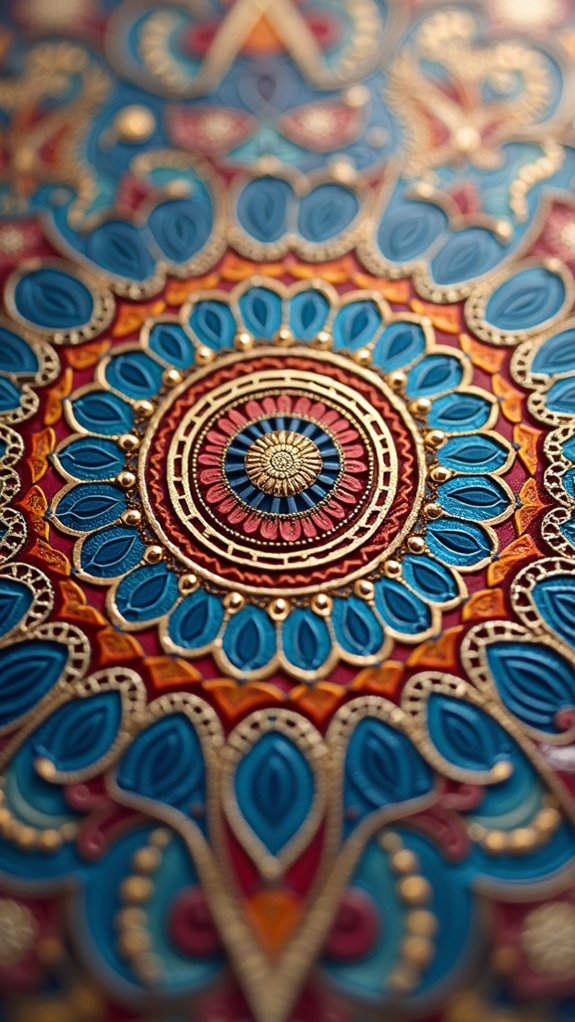
Creating geometric mandalas requires perfect symmetry, which artists can achieve using a few specific tools and techniques. A compass becomes the artist’s best friend, allowing for crisp circles and arcs, while rulers and protractors guarantee those triangles and squares line up just right!
These essential tools transform a blank page into a mathematical masterpiece, giving even beginners the power to create stunning, precise patterns that seem to dance across the paper.
Perfect Symmetry Techniques
Achieving perfect symmetry transforms ordinary mandalas into mesmerizing geometric masterpieces! To master these perfect symmetry techniques in Mandala Art, begin with essential tools: a compass and ruler create the precise foundation needed for balanced designs.
Divide your circle into equal sections using a protractor—this vital step guarantees every element mirrors perfectly across your artwork.
Start simple! Basic shapes like triangles and squares form your mandala’s building blocks. As your confidence grows, layer additional patterns while maintaining that satisfying symmetry.
Fine-tip black pens work wonders for those intricate details that make geometric mandalas so enchanting.
Geometric Tool Essentials
The perfect geometric mandala starts with the right tools in your creative arsenal! A drawing compass, ruler, and protractor are absolute must-haves for creating those jaw-dropping, perfectly symmetrical patterns that’ll make your friends say “Wow!”
The compass creates flawless circles, while the ruler and protractor guarantee your lines and angles are spot-on every time.
Don’t forget to grab a fine-tip black pen (0.4mm works great!) for adding those super-detailed touches that make geometric mandalas pop!
Starting with a grid or dividing your paper into equal sections is a total game-changer for maintaining symmetry.
Try mixing triangles and squares with your circular designs for a modern, structured look that’s both mathematical and artistic.
These geometric tool essentials will transform your mandala game forever!
Watercolor Mandala Techniques: Blending Colors for Dreamy Designs
Watercolor mandalas transport artists into a world of soft, flowing designs where colors dance together in harmony.
The dreamy, ethereal patterns emerge from the fluid nature of watercolors, creating a mesmerizing visual experience that’s both calming and beautiful.
Artists achieve smooth shifts by using wet-on-wet techniques, where pigments blend effortlessly on damp paper.
Building layers is essential—start with light hues and gradually add deeper tones for dimension.
For extra pizzazz, sprinkle salt or dab alcohol onto wet paint to create fascinating textures that make viewers say “wow!”
Mixed-Media Mandalas: Combining Materials for Textured Masterpieces

While traditional mandalas use a single medium, mixed-media mandalas burst with dimension and personality by combining different materials into one cohesive design.
Artists can blend paints, markers, collage elements, and textured papers to create stunning, tactile artwork that jumps off the page. This approach transforms simple patterns into richly layered masterpieces that engage both sight and touch.
For those enthusiastic to try mixed-media mandalas, consider these options:
- Start with a watercolor base, then add definition using fine-tip markers
- Incorporate natural elements like pressed flowers or leaves
- Apply metallic foil for sections that catch the light
- Layer tissue paper for translucent color effects
The wonderful thing about mixed-media mandalas is their therapeutic quality—each material offers a different sensory experience, making the creative process both relaxing and wildly fun!
Digital Mandala Creation: Tools and Tips for Electronic Artists
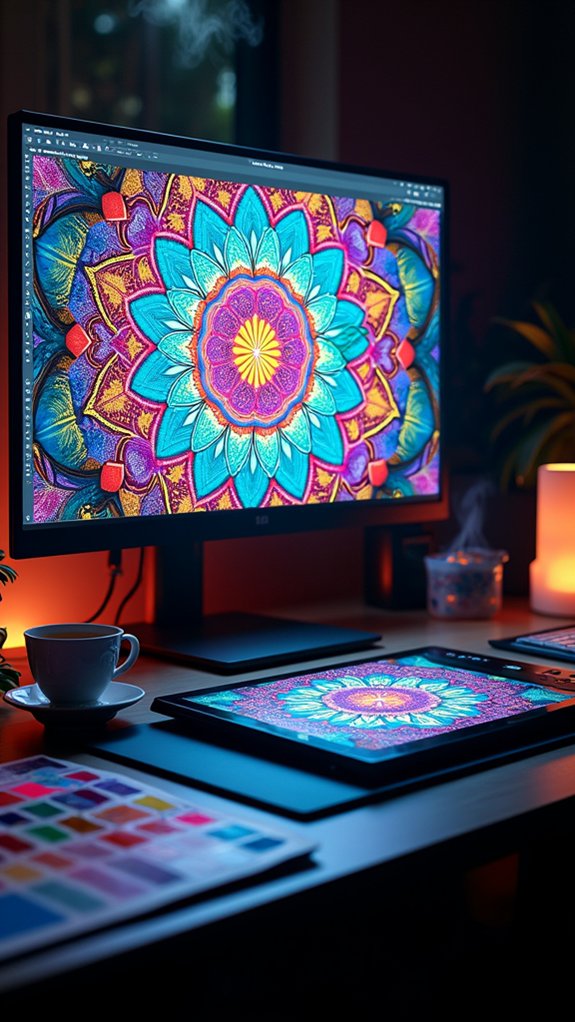
Digital artists now have a world of possibilities at their fingertips when creating mandalas, thanks to modern technology and specialized software. Programs like Adobe Illustrator and free alternatives such as Inkscape offer precision tools that make intricate pattern-making a breeze!
The digital evolution has revolutionized mandala creation, putting infinite design potential into artists’ hands with just a few clicks.
For beginners and experts alike, apps like Procreate and Mandala Maker provide amazing symmetry features that instantly multiply your designs.
The coolest part of digital mandala creation? The unlimited color options! Artists can experiment with vibrant palettes and layer techniques that would be impossible with traditional materials.
Plus, saving work in various formats (PNG, JPEG, or SVG) means these beautiful designs can appear on anything from printed posters to animated displays.
Online communities are bursting with tutorials for all skill levels, making it easy to engage with this fascinating digital art form!
Mindful Mandala Drawing: Meditation Through Artistic Expression

Have you ever noticed how time seems to slip away when you’re completely absorbed in creating something beautiful? This is exactly what happens during mindful mandala drawing, where artistic expression meets meditation in a colorful dance of patterns and shapes.
As your pen glides across the paper, stress melts away, replaced by a calm focus that nurtures your mind and spirit.
Ready to start your mindful mandala journey? Here’s how:
- Gather quality tools like fine-tip pens and colored pencils for creating intricate details
- Begin with a central point, allowing patterns to flow outward naturally
- Incorporate personal symbols that hold meaning for you
- Focus on your breathing as you draw, letting repetitive patterns guide you into a meditative state
Mandala Dot Art: Creating Intricate Designs One Dot at a Time
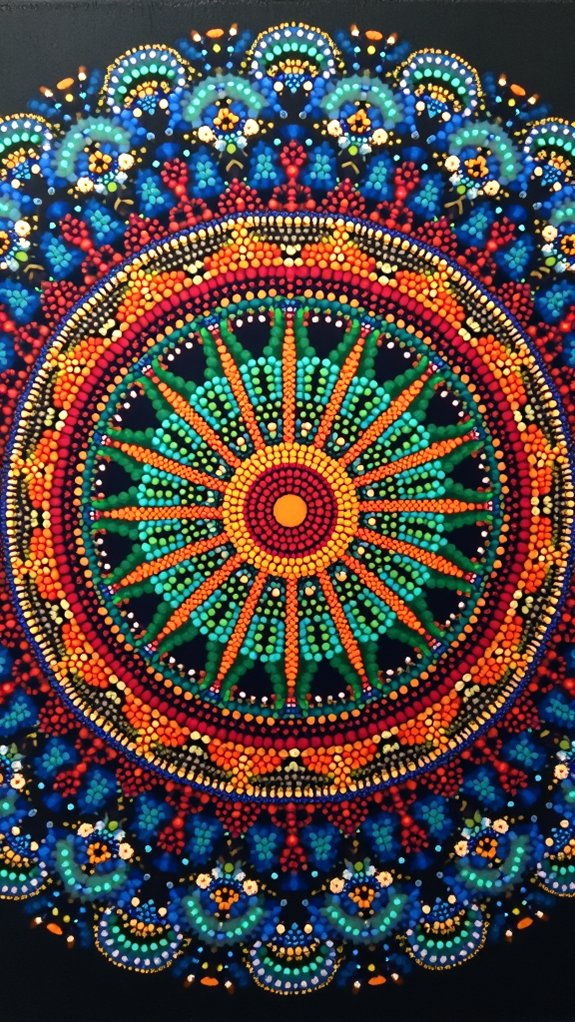
Discovering the mesmerizing world of mandala dot art invites artists of all levels to embrace the beauty of patience, as each carefully placed dot contributes to stunning patterns that emerge over time.
Artists can experiment with layered dotting techniques, starting with base designs and gradually building complexity through overlapping dots of varying sizes and densities.
The magic truly happens when colors harmonize within the mandala, creating visual rhythm and emotional resonance that transforms simple dots into breathtaking artistic expressions.
Patience Creates Perfection
Patience unfolds like a delicate flower when creating mandala dot art, revealing intricate patterns one tiny dot at a time.
Like hand-drawn mandalas, these dotted masterpieces transform blank canvases into mesmerizing designs that capture both the eye and mind. The deliberate placement of each dot creates a meditative rhythm that calms the busiest thoughts.
The path to dot art perfection includes:
- Starting with a central dot as your anchor point
- Working outward in expanding circles, one precise dot after another
- Using various tools like brushes, pencil ends, or specialized dotting implements
- Embracing mistakes as opportunities for creative detours
This patient practice isn’t just about creating beautiful art—it’s about finding your center while the worries of the day melt away, replaced by colorful expressions of creativity.
Layered Dotting Techniques
Layered dotting transforms simple mandala art into enchanting works with remarkable depth and dimension.
Artists build these mesmerizing patterns one dot at a time, creating wonderful illusions that seem to pop off the page!
Using fine-tip dotting tools, artists stack dots of different sizes and colors to create mind-blowing 3D effects.
It’s like magic watching flat surfaces come alive! Some artists start with larger dots as a base, then add smaller, contrasting dots on top—making the design practically dance before your eyes.
The best part? Anyone can try this!
Beginners might start with simple patterns, while pros create insanely detailed masterpieces.
Your hands might get a bit tired (seriously, so many dots!), but seeing your finished layered mandala makes every moment worth it.
Color Harmony Matters
Colors create the heartbeat of any mandala dot art, bringing designs to life through carefully chosen combinations that wow the eye!
Color harmony matters when crafting these mesmerizing patterns, and understanding how different hues interact can take your mandala ideas from good to spectacular.
- Complementary colors (like purple and yellow) create exciting contrast that makes dots pop against each other.
- Analogous palettes use colors that sit next to each other on the color wheel, creating soothing, harmonious mandala designs.
- Gradient progressions from light to dark add depth and dimension, making your dots appear to float.
- Monochromatic schemes utilize various shades of a single color, perfect for beginners who want stunning results without color-matching stress.
Experimenting with these color relationships transforms simple dot patterns into vibrant, eye-catching mandalas that captivate viewers!
Seasonal Mandalas: Capturing the Essence of Each Time of Year
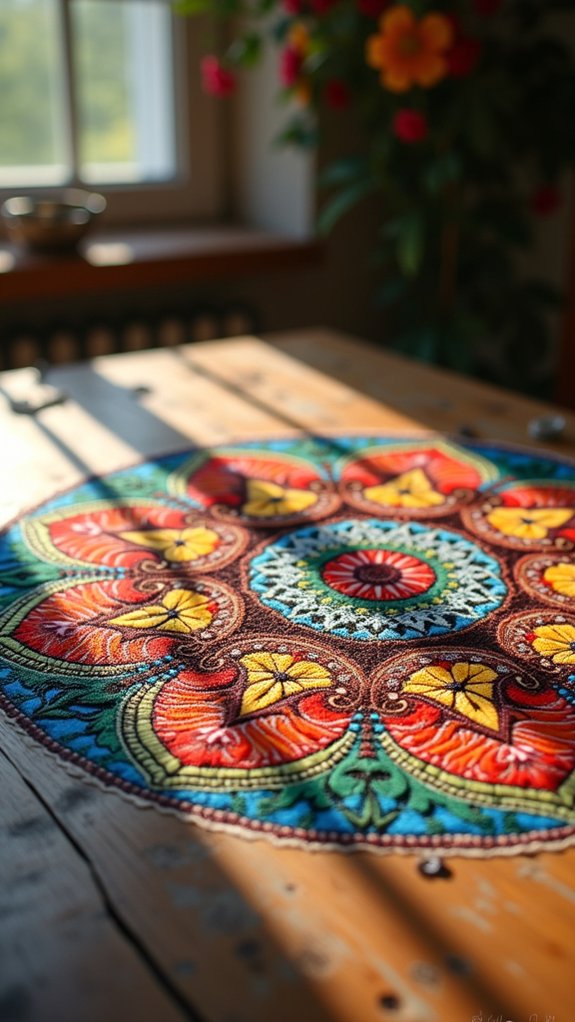
When the world outside transforms with each passing season, artists can harness this natural rhythm through the creation of seasonal mandalas. These circular designs become vibrant reflections of nature’s changing moods, with spring mandalas bursting with greens and floral patterns, while autumn pieces showcase warm oranges and earthy browns.
Seasonal mandalas offer more than just beautiful art—they provide therapeutic benefits too! Artists often incorporate symbolic elements like snowflakes for winter or sunflowers for summer, making each creation uniquely meaningful. The process of designing these patterns connects creators to the natural world while expressing emotions tied to seasonal shifts.
For those looking to add personal touches to holiday celebrations, seasonal mandalas make perfect decorations. Using materials and color schemes inspired by the outdoors—like pressed leaves for fall designs—adds authenticity and depth to these enchanting circular masterpieces.
Mandala Home Décor Projects: From Wall Art to Functional Items
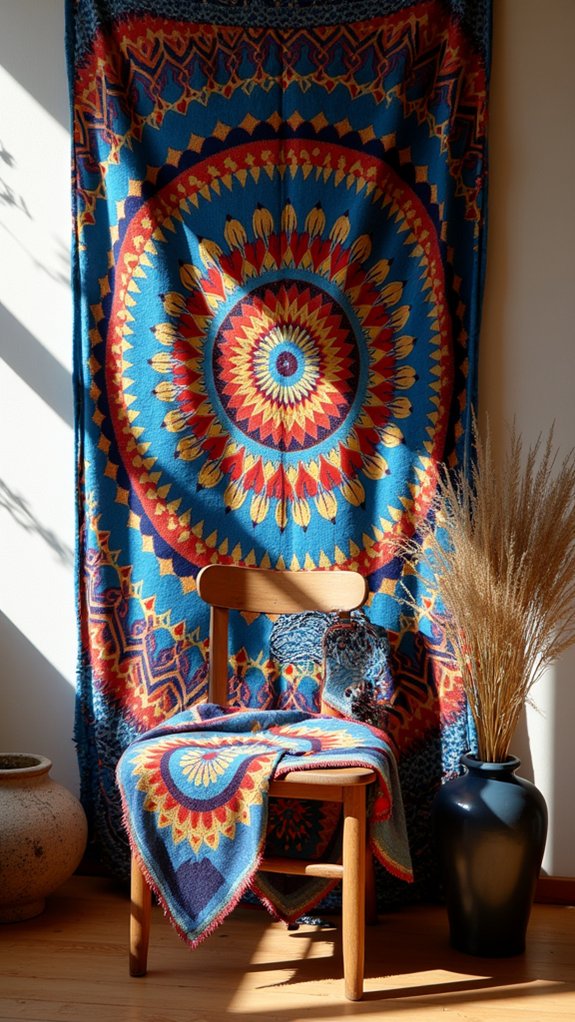
Mandala designs can transform ordinary home items into beautiful works of art that reflect your personal style and add warmth to any space.
From elegant textile pieces like curtains, throw pillows, and table runners adorned with intricate mandala patterns, to simple DIY mandala coasters that protect surfaces while showcasing your creativity, the possibilities are endless.
These projects not only enhance your home’s visual appeal but also create peaceful focal points that invite moments of calm reflection whenever you encounter them.
Elegant Mandala Textiles
The transformation of ordinary fabric into stunning mandala-inspired masterpieces opens up endless possibilities for home décor enthusiasts.
These textiles showcase intricate details through various techniques, bringing both beauty and function to living spaces.
Mandala textiles can uplift your home in these ways:
- Transform plain walls with tapestries featuring circular, symbolic patterns that draw the eye and create focal points.
- Add cozy comfort with mandala-patterned pillows and throws in soft pastels.
- Create practical art through embroidered table runners or painted fabric coasters.
- Enhance windows with translucent mandala curtains that filter light into mesmerizing patterns.
Whether through DIY projects or purchased pieces, these textiles offer a personal touch that promotes tranquility while expressing creative vision, making any space uniquely yours.
DIY Mandala Coasters
Crafting your own mandala coasters brings functional art into daily life while adding a personal touch to your home décor collection. These versatile projects can transform plain cork, wood, or ceramic bases into stunning conversation pieces that protect surfaces in style!
To make your mandala masterpieces, begin by sketching designs on paper before carefully transferring them to your chosen material. Grab some vibrant acrylic paints or permanent markers and let your creativity flow—each swirl and pattern helps release stress while creating something beautiful!
Don’t forget to seal your finished artwork with clear varnish or resin to protect it from coffee spills and condensation.
The best part? These coasters aren’t just pretty to look at; the meditative process of creating them offers a peaceful escape from hectic daily routines. Who knew functional items could be so zen?
Cultural Mandala Inspiration: Exploring Traditional Designs Worldwide
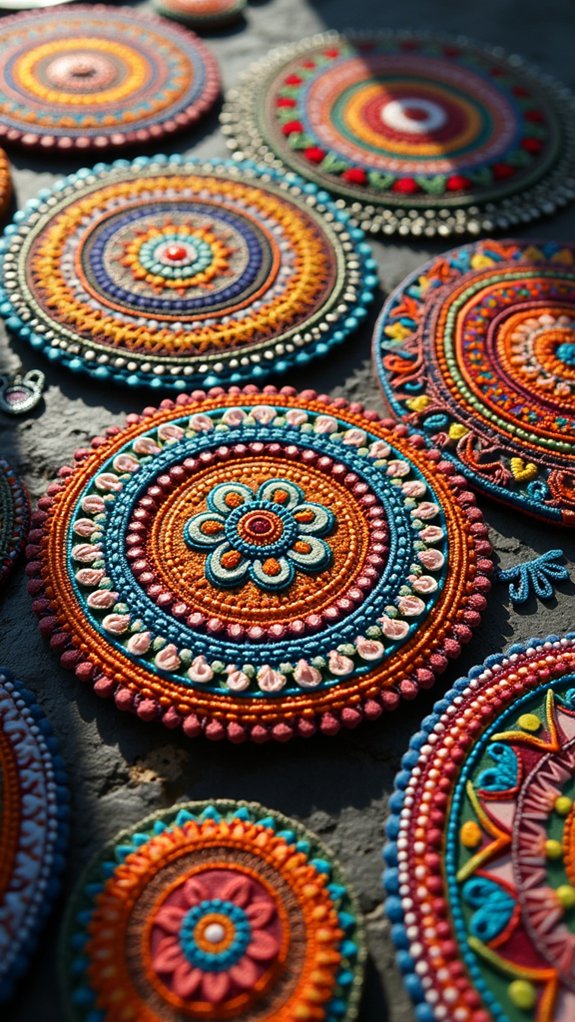
Around the world, diverse cultures have developed their own unique expressions of the sacred circle, creating a rich tapestry of mandala traditions worth exploring.
These cultural mandala inspiration sources can spark your own creative journey!
- Tibetan Buddhist mandalas use colored sand to create intricate designs that are later destroyed – a powerful reminder that nothing lasts forever.
- Hindu Rangoli brings good luck with vibrant patterns made from rice, flowers, and colored powders during festivals.
- Native American medicine wheels celebrate the cycles of nature using stones and plants to show how everything is connected.
- African tribal mandalas tell amazing stories through beadwork and textiles, using bold colors that practically jump off the surface!
Each tradition offers unique patterns and meanings to inspire your next mandala creation.
Frequently Asked Questions
Is Mandala Art Good for Mental Health?
Research indicates mandala art benefits mental health through mindful expression. It reduces anxiety, improves concentration, and fosters emotional well-being by encouraging focused creation in a meditative state.
What Are the 5 Types of Mandalas in Art?
The five distinct types of mandalas include nature-inspired, geometric patterns, flower-based, pastel-colored, and mixed-media designs. Each style offers unique approaches to symmetry, color application, and artistic expression.
What Is the Rule for Creating Mandalas?
The fundamental design principle for creating mandalas is maintaining symmetry around a central point, with patterns radiating outward in balanced sections while employing repetition to achieve harmony and visual flow.
What Is a Healing Mandala?
A healing mandala is a symmetrical art form featuring intricate patterns that provide meditative benefits through fostering mindfulness, emotional balance, and stress reduction when created or contemplated during therapeutic practice.
Conclusion
Mandala art offers a wonderful escape into creativity that anyone can enjoy. These ten ideas are just the beginning of your artistic journey! Whether you’re drawing with dots, painting with watercolors, or designing digitally, mandalas help calm your mind while creating something beautiful. Don’t worry about perfection—each design is uniquely yours. So grab your supplies, put on some relaxing music, and let the magical patterns flow from your imagination!


Leave a Reply